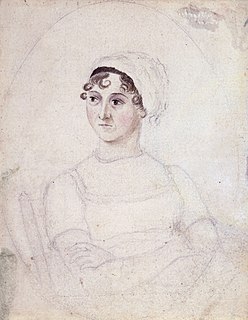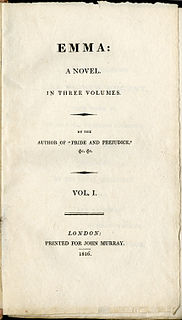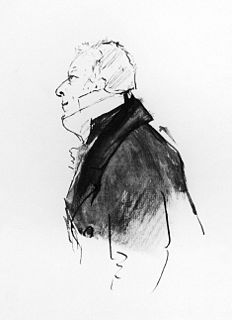Related Research Articles

Jane Austen was an English novelist known primarily for her six major novels, which interpret, critique, and comment upon the British landed gentry at the end of the 18th century. Austen's plots often explore the dependence of women on marriage in the pursuit of favourable social standing and economic security. Her works critique the novels of sensibility of the second half of the 18th century and are part of the transition to 19th-century literary realism. Her use of biting irony, along with her realism and social commentary, have earned her acclaim among critics and scholars.

Emma is a novel about youthful hubris and romantic misunderstandings, written by Jane Austen. It is set in the fictional country village of Highbury and the surrounding estates of Hartfield, Randalls and Donwell Abbey, and involves the relationships among people from a small number of families. The novel was first published in December 1815, with its title page listing a publication date of 1816. As in her other novels, Austen explores the concerns and difficulties of genteel women living in Georgian–Regency England. Emma is a comedy of manners.

John William Ponsonby, 4th Earl of Bessborough, PC, known as Viscount Duncannon from 1793 to 1844, was a British Whig politician. He was notably Home Secretary in 1834 and served as Lord Lieutenant of Ireland between 1846 and 1847, the first years of the Great Famine.
Harriet Lee was an English novelist and playwright.

Clara Mary Jane Clairmont, or Claire Clairmont as she was commonly known, was the stepsister of the writer Mary Shelley and the mother of Lord Byron's daughter Allegra. She is thought to be the subject of a poem by Percy Bysshe Shelley.

William Wellesley-Pole, 3rd Earl of Mornington,, known as Lord Maryborough between 1821 and 1842, was an Anglo-Irish politician and an elder brother of the Duke of Wellington. His surname changed twice: he was born with the name Wesley, which he changed to Wesley-Pole following an inheritance in 1781. In 1789 the spelling was updated to Wellesley-Pole, just as other members of the family had changed Wesley to Wellesley.

Elizabeth Inchbald was an English novelist, actress and dramatist. She wrote two novels that have remained prominent to this day. She successfully translated and adapted several plays from German and French.

Sydney, Lady Morgan, was an Irish novelist, best known for The Wild Irish Girl (1806), a romantic, and some critics suggest, "proto-feminist", novel with political and patriotic overtones. Her work, including continental travelogues, sparked controversy and faced censorship. She counted Percy Bysshe Shelley and Lord Byron among her defenders.

Sophia Lee was an English novelist, dramatist and educator. She was a formative writer of Gothic fiction. She and her sister Harriet also wrote a number of Canterbury Tales (1797).
Jane West, was an English novelist who published as Prudentia Homespun and Mrs. West. She also wrote conduct literature, poetry and educational tracts.
John Hearle Tremayne was a member of a landed family in the English county of Cornwall, and owner of the Heligan estate near Mevagissey. He was a member of the UK Parliament for the constituency of Cornwall, a Justice of the peace, and High Sheriff of Cornwall in 1831. He was also the second of four successive members of the Tremayne family who are credited with the creation of the gardens around Heligan House that are now well known as the Lost Gardens of Heligan.

Sir John Salusbury Salusbury-Trelawny, 9th Baronet, was a British Liberal politician.

Percy Bysshe Shelley was one of the major English Romantic poets. A radical in his poetry as well as in his political and social views, Shelley did not achieve fame during his lifetime, but recognition of his achievements in poetry grew steadily following his death and he became an important influence on subsequent generations of poets including Robert Browning, Algernon Charles Swinburne, Thomas Hardy, and W. B. Yeats. American literary critic Harold Bloom describes him as "a superb craftsman, a lyric poet without rival, and surely one of the most advanced sceptical intellects ever to write a poem."

Thomas Medwin (1788–1869) was an early 19th-century English writer, poet and translator. He is known chiefly for his biography of his cousin, Percy Bysshe Shelley, and for published recollections of his friend, Lord Byron.
Henrietta Maria Bowdler (1750–1830), commonly called Mrs. Harriet Bowdler, was an English religious author and literary expurgator, notably of the works of William Shakespeare.

Harriet Grote (1792–1878) was an English biographer. She was married to George Grote and was acquatined with many of the English philosophical radicals of the earlier 19th century. A longterm friend described her as "absolutely unconventional".

Georgiana Bloomfield, Baroness Bloomfield, was a British courtier and author.
Maria Elizabetha Jacson was an eighteenth-century English writer, as was her sister, Frances Jacson (1754–1842), known for her books on botany at a time when there were significant obstacles to women's authorship. In some sources her name appears as Maria Jackson, Mary Jackson or Mary Elizabeth Jackson. She spent most of her life in Cheshire and Derbyshire, where she lived with her sister following her father's death.
Maria Ponsonby, Viscountess Duncannon, formerly Lady Maria Fane, was the wife of John Ponsonby, 4th Earl of Bessborough. She died before he inherited the earldom and thus was never Countess of Bessborough, but three of her sons were successively earls of Bessborough.
References
- 1 2 Fox-Davies, Arthur Charles (1910). Armorial Families: A Directory of Gentlemen of Coat-armour. T.C. & E.C. Jack.
- 1 2 Lodge, Edmund (1890). The Peerage and Baronetage of the British Empire as at Present Existing. Hurst and Blackett, limited.
- 1 2 3 "Author: Harriet Jane Trelawny". www.victorianresearch.org. Retrieved 2022-09-13.
- ↑ Trelawny, Lady Harriet Jane (1879). Sister [by lady H.J. Trelawny]. Smith, Elder & Company.